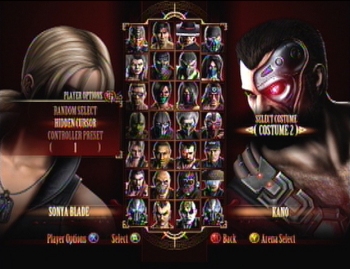
Notice the “Hidden Cursor” option put in to thwart a practice called “counter picking” which kinda makes sense for tournament level play, but for us average gamers it’s a stupid option for stupid people kidding themselves.
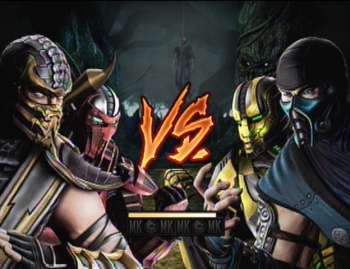
New to Mortal Kombat: tag team battles for which I’ve never seen the appeal. I dunno, it’s always struck me as gimmick. A harmless gimmick, but a gimmick none-the-less.
Review by Jay Wilson With reboots and remakes plaguing the film industry, it was only a matter of time before the phenomena came home to video games. In the opening intro of story mode, we see the conclusion of MK: Armageddon where Raiden loses to Shao Kahn promising eternal darkness, the destruction, and other less happy things. So, a desperate Thunder God sends a message back in time to his past self—to the first tournament to be specific—and so this latest entry goes on to retell the story of Mortal Kombats 1, 2, and 3 and features the characters and classic stages of said games with Quan Chi thrown in for the hell of it, conveniently saving me the trouble of discussing them (again). In a way, Mortal Kombat (2011) is the greatest hits of the franchise. While the graphics are rendered in 3D, MK9 abandons its Z-axis to once again anchor its fighters to a 2D battle plane, but that doesn’t mean it plays like the games from twenty years ago. Superficial changes include relabeling High Punch, Low Punch, High Kick, and Low Kick as Front Punch, Back Punch, Front Kick, and Back Kick. More noticeable, however, are the inexplicably input changes to classic moves such as Kitana’s fan toss which used to be executed by tapping forward twice and pressing HP+LP together. Now? Quarter-circle forward and FP. A similar alteration befell Sektor’s teleport punch (forward-forward LK became quarter-circle forward FK). I guess an argument could be made that with the addition of a forward dash (performed by tapping forward twice) the double forward inputs were changed to prevent unwanted dashes ... but Mileena’s teleport kick still uses the old forward-forward method. It’s easy enough to adjust, don’t get me wrong, but, I dunno, the forward-forwards and back-backs were pretty unique to MK, and it seems arbitrary that some changed while others did not. Oh well. More importantly: for the first time in the franchise’s 2D history, Mortal Kombat brings a full array of mixups making the fights far more interesting. Overheads mercifully come into the fold which finally defeats a crouch block meaning annoying turtles who guard low all day long just waiting for a chance to use their uppercut now have a reason to stand up or get punished. It also finally gives an offensive player a chance to force mindgames on his opponent concerning where to block (high and risk a sweep, or low and risk an overhead.) The aforementioned dash allows an aggressor to close in and remain point blank in a way he never could before (and, no, the MK3 ‘run’ button didn’t cut it.) Plus defensive options such as staying on the ground a second longer to throw off your opponents timing, the option to roll backwards to escape their pressure game, and to perform a “wakeup attack” as you get up—all lead to a deeper, more engaging, fighting experience. 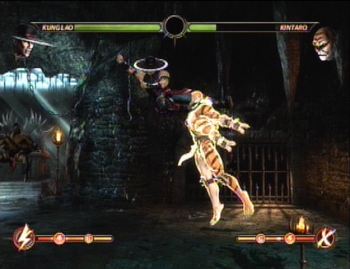
May I draw your attention to the gold aura around Kintaro which means “I don’t care if you can kick me in the face, I’m a boss and can arbitrarily ignore your attacks.”
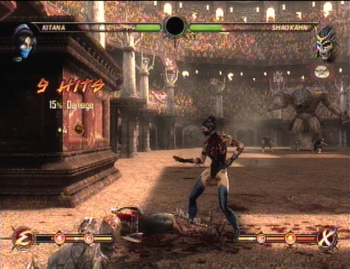
Notice the damage on Kitana’s nine-hit combo. On normal characters, the damage would be twice that (which, by the way, cost one bar of super meter to execute), but Shao Kahn and his fellow bosses are “special.”
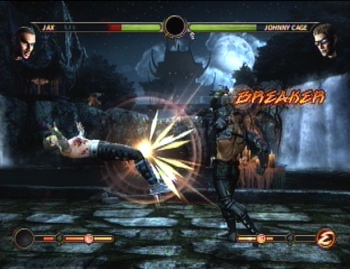
Given MK9’s ridiculous number of setup moves (Scorpion’s Spear, Sub-Zero’s freeze, etc), I really think the Breaker should cost one level of meter and Enhanced moves cost two instead of the other way around.
Animation wise, combos flow more smoothly from the days of 2D sprites; however, the inputs for the most basic combos seem watered down (not to mention repetitive from character to character) and simplified from the MK3 era dial-a-combos. Perhaps because MK3’s combos often went beyond five button taps (like Sub-Zero’s HP HP LP LK HK back+HK) and the MK9 combos rarely go to (much less beyond) four. However, acting as a lifeline, the new system allows a player to link two or more combos together. In a corner Kitana can use Deadly Rush (forward+BK FP), a standard combo where she kicks them and then slams them into the ground with her fans. If it successfully connects, they’ll actually bounce off the ground which allows Kitana to then catch them with an Enhanced Fan Lift which, in turn, sets them up for a jump kick, air Fan Toss, Ground Fan Toss, Uprise (basically a combo-friendly uppercut), and air Square Boost for a ten hit 35% damaging combo that utilizes an array of different moves. Fun to perform and fun to watch. Unfortunately, the new system also opens the door for the painfully monotonous, glorified button-masher combos such as Liu Kang’s nine-hit 27% triple Fierce Tiger which literally consists of mashing out the same three hit combo (BP FP FK) thrice in a corner. Then there’s other combos beyond my level of dedication consisting of a launcher, followed by a string of three to five standing Front Punches to juggle an enemy in the corner, ultimately leading to another combo. Those sorts of combos certainly get the job done, but are boring as hell to watch while in an online King of the Hill room waiting for your turn. Taking a cue from many-a-Capcom fighters, Mortal Kombat 2011 introduces a super meter broken into three sections. One full section allows a character to perform an enhanced version of a special move (often handy in linking two combos together for one massive combo as described above). Two sections permits a Killer Instinct inspired (combo) Breaker which allows the player to break out of one of those “juggle away half your life” combos. And with all three bars fully charged, you may unleash the visually spectacular X-Ray moves which, as its name implies, uses the full power of 3D to zoom in close and show internal damage such as bones breaking and teeth shattering. Since the meter fills up by taking damage and having your attacks blocked (among other things), this makes X-Rays something of a “comeback” mechanic, a move which takes off about a third of your opponents lifebar to, in theory, get you back into the fight if you were behind (or widen the gap and prevent an upset if you’re ahead.) From a gameplay standpoint, the addition is welcomed into the world of MK as it introduces a fun complication into the equation. The high damage all but demands a player to change their strategy when they notice their opponent’s X-ray gauge ready to go. For example, Kung Lao’s X-ray is an awesome anti-air move, and the threat of it forces his opponent to stay grounded. Jax’s is an unblockable throw, so when his meter is charged you need to be as far away as you can get. Similarly, Johnny Cage’s X-ray is actually a counter-attack, completely useless unless his opponent attempts to hit him during a small window, and when his meter reads X it’s a mind game between him trying to get you to walk into his trap and you trying to bait him into wasting it. Sheeva will stomp the ground for her X-ray, connecting against anyone not airborne so, naturally, you need to be ready to jump at the drop of a hat. 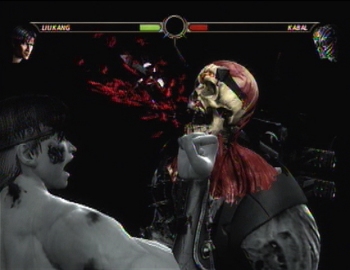
Weird: Liu Kang’s X-ray is his MK1 “Fatality” which is somehow cooler than both of his MK9 Fatalities. Even weirder: one of his MK9 Fatalities is a reprise of MK2’s (awesome) dragon ... only it somehow looks dumb in 3D.

Well, at least there’s a semi-funny character specific animation this time around, but that doesn’t change the fact Babalities have always been and will always be retarded.
Furthermore, meter management comes into play. With enhanced specials, breakers, and X-rays all tied to the same meter, a player must consciously choose how and when to use it. With a sliver of life, do you attempt a breaker to hopefully survive this round or do you give up this round with the hopes of executing an X-ray right off next round? Do you use one bar of meter now to enhance a move and double the damage of a (breakable) combo, or do you save up for an unbreakable X-ray? It adds to the options but remains relatively simple, making the game more interesting without drowning the experience in unnecessary clutter. Finishing moves, finishing moves, what would MK be without finishing moves? MK9 gives each of its twenty-seven characters two Fatalities, one Stage Fatality, and one ... *sigh* Babality. You had to bring that back, didn’t you NRS? Anyway, the game goes all out with the violence—Kung Lao slices his victim in half with his hat, Kitana slices her opponent’s arms off before decapitating them, Sheeva rips their arms off then smacks them around with their own hands. Several pay tribute to classic Fatalaties such as Quan Chi’s MK4 leg rib/beat down, Jax’s MK2 head crush and arm rip, and Johnny Cage’s MK1 uppercut decapitation. Not all Fatalities are winners, though, such as Liu Kang’s fiery punch through his opponent’s chest, Cyber Sub-Zero’s ninja star to the skull, and Cage’s second Fatality where he karate chops their head in half and then sticks his Oscar on the bloody stump which all feel “bleh” juxtaposed to Scorpion stabbing his victim with his spear, wrapping the chain around their neck, then kicking them through one portal only to have them pop out of a second portal overhead, lynched and burned to a crisp. Although the absolute worst offender is Shang Tsung with his—I kid you not—“clown” Fatality. You see, in MKvsDC, DC Comics felt compelled to force Midway (now NetherRealm Studios) to censor the Joker’s Fatality where he ‘shoots’ his victim with a fake gun (complete with a ‘Bang!’ flag) and then pulls out a real gun and blows their head off. So in a move that makes NetherRealm Studios look like a bunch of thin-skinned petty rebel-wannabes, they felt compelled to break Shang Tsung’s “evil-sorcerer from another realm” character, give him a completely inappropriate and out-of-context Finisher just to uncensored a Fatality from an entirely censored game. But I digress. Mortal Kombat 2011 takes advantage of the 3D models/environment to give a cinematic quality to the pre-fight introductory animations, post-fight victory poses, the X-rays, and, yes, the Finishing Moves. The camera isn’t afraid to zoom in on breaking ribs, shattering teeth, and snapping limbs, and amidst a Fatality it cuts to different camera angles to maximize the impact of the winner reducing the loser to a bloody puddle of gore—in effect, the X-rays and Fatalities are mini-cut scenes triggered every single time a player executes the correct input. And like all cut scenes, it’s all fine and dandy the first few times you see it. However, I dunno about you, but once I’ve seen a cut scene I just want to skip the damn thing every other time I play ... and I hate unskippable cut scenes. 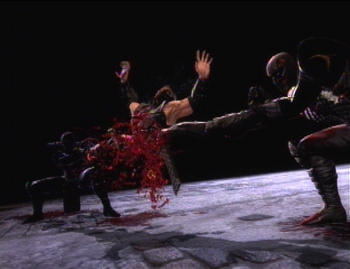
Noob Saibot and his shadow double/companion/whatever use Smoke as a wishbone with gruesome results.
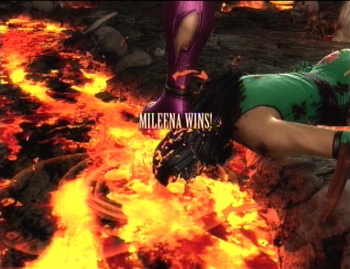
It’s not enough that the winner throws the loser face first into the Hell Stage’s lava, but when they try to get up the winner stomps on their head and puts them down for good.
One of the paradoxical strengths of 2D sprite-based games is that the camera angle and zoom never changes, and so they never draw attention to their repetition. Also, the very nature of 2D sprites ensures that all animations are quick and to the point. By contrast, 3D has the luxury of pausing, lingering, and dwelling. Thus, the MK2 Fatalities never get old, and even if you don’t like a Fatality ... it only takes a second or two. In the realm of 3D, the door to more cinematic options is available, but in the context of a fighting game where people tend to stick to a few characters and a few moves for said characters ... that translates to the same exact pre-fight character introduction (of which there is only one per character), the same exact victory pose (again, only one per character), and for X-rays and Fatalities that means the exact same in-your-face camera maneuvers, to the exact same editing beats, to the exact same animations. It might be flashy as all hell, but that doesn’t keep it from getting repetitive, monotonous, and, yes, boring. Fatalities? I might be able to tolerate (although, now, truthfully I prefer to just throw, uppercut, or perform a nifty looking special move.) X-Rays and other mid-match mini-cutscene moves such as Street Fighter IV’s Ultras, I can’t forgive on the basis that, with few exceptions, when I sit down to play a game ... I expect to play a game and not watch a collection of repetitive unskippable cutscenes. X-rays only take a few brief seconds, yes, but I’d rather spend that time pushing my attack executing an active combo instead of watching a passive one. This is a fighting game, after all, and I play it to engage in a competition of game knowledge, pattern recognition, dexterity, and reflexes—all active components. If I want to watch a quick video clip, that’s what YouTube is for. | ||||||||||||||||||||
|
| ||||||||||||||||||||
